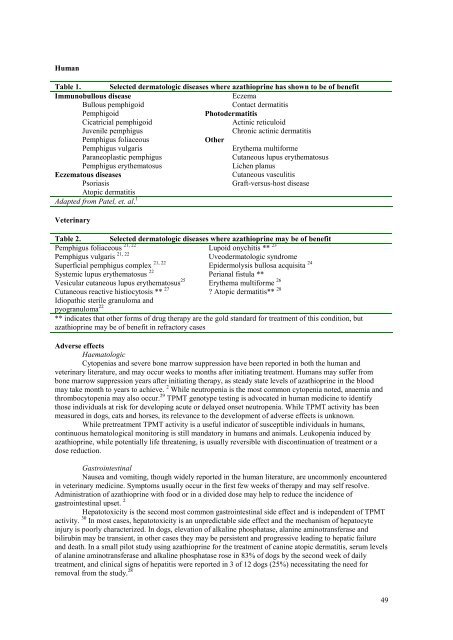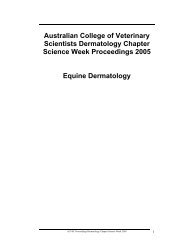Azathioprine and chlorambucil: mechanism of action and use in ...
Azathioprine and chlorambucil: mechanism of action and use in ...
Azathioprine and chlorambucil: mechanism of action and use in ...
Create successful ePaper yourself
Turn your PDF publications into a flip-book with our unique Google optimized e-Paper software.
Human<br />
Table 1. Selected dermatologic diseases where azathiopr<strong>in</strong>e has shown to be <strong>of</strong> benefit<br />
Immunobullous disease Eczema<br />
Bullous pemphigoid Contact dermatitis<br />
Pemphigoid Photodermatitis<br />
Cicatricial pemphigoid Act<strong>in</strong>ic reticuloid<br />
Juvenile pemphigus Chronic act<strong>in</strong>ic dermatitis<br />
Pemphigus foliaceous Other<br />
Pemphigus vulgaris Erythema multiforme<br />
Paraneoplastic pemphigus Cutaneous lupus erythematosus<br />
Pemphigus erythematosus Lichen planus<br />
Eczematous diseases Cutaneous vasculitis<br />
Psoriasis Graft-versus-host disease<br />
Atopic dermatitis<br />
Adapted from Patel, et. al. 1<br />
Veter<strong>in</strong>ary<br />
Table 2. Selected dermatologic diseases where azathiopr<strong>in</strong>e may be <strong>of</strong> benefit<br />
Pemphigus foliaceous 21, 22 Lupoid onychitis ** 23<br />
Pemphigus vulgaris 21, 22 Uveodermatologic syndrome<br />
Superficial pemphigus complex 21, 22 Epidermolysis bullosa acquisita 24<br />
Systemic lupus erythematosus 22 Perianal fistula **<br />
Vesicular cutaneous lupus erythematosus 25 Erythema multiforme 26<br />
Cutaneous reactive histiocytosis ** 27<br />
Idiopathic sterile granuloma <strong>and</strong><br />
? Atopic dermatitis** 28<br />
pyogranuloma 22<br />
** <strong>in</strong>dicates that other forms <strong>of</strong> drug therapy are the gold st<strong>and</strong>ard for treatment <strong>of</strong> this condition, but<br />
azathiopr<strong>in</strong>e may be <strong>of</strong> benefit <strong>in</strong> refractory cases<br />
Adverse effects<br />
Haematologic<br />
Cytopenias <strong>and</strong> severe bone marrow suppression have been reported <strong>in</strong> both the human <strong>and</strong><br />
veter<strong>in</strong>ary literature, <strong>and</strong> may occur weeks to months after <strong>in</strong>itiat<strong>in</strong>g treatment. Humans may suffer from<br />
bone marrow suppression years after <strong>in</strong>itiat<strong>in</strong>g therapy, as steady state levels <strong>of</strong> azathiopr<strong>in</strong>e <strong>in</strong> the blood<br />
may take month to years to achieve. 2 While neutropenia is the most common cytopenia noted, anaemia <strong>and</strong><br />
thrombocytopenia may also occur. 29 TPMT genotype test<strong>in</strong>g is advocated <strong>in</strong> human medic<strong>in</strong>e to identify<br />
those <strong>in</strong>dividuals at risk for develop<strong>in</strong>g acute or delayed onset neutropenia. While TPMT activity has been<br />
measured <strong>in</strong> dogs, cats <strong>and</strong> horses, its relevance to the development <strong>of</strong> adverse effects is unknown.<br />
While pretreatment TPMT activity is a <strong>use</strong>ful <strong>in</strong>dicator <strong>of</strong> susceptible <strong>in</strong>dividuals <strong>in</strong> humans,<br />
cont<strong>in</strong>uous hematological monitor<strong>in</strong>g is still m<strong>and</strong>atory <strong>in</strong> humans <strong>and</strong> animals. Leukopenia <strong>in</strong>duced by<br />
azathiopr<strong>in</strong>e, while potentially life threaten<strong>in</strong>g, is usually reversible with discont<strong>in</strong>uation <strong>of</strong> treatment or a<br />
dose reduction.<br />
Gastro<strong>in</strong>test<strong>in</strong>al<br />
Na<strong>use</strong>a <strong>and</strong> vomit<strong>in</strong>g, though widely reported <strong>in</strong> the human literature, are uncommonly encountered<br />
<strong>in</strong> veter<strong>in</strong>ary medic<strong>in</strong>e. Symptoms usually occur <strong>in</strong> the first few weeks <strong>of</strong> therapy <strong>and</strong> may self resolve.<br />
Adm<strong>in</strong>istration <strong>of</strong> azathiopr<strong>in</strong>e with food or <strong>in</strong> a divided dose may help to reduce the <strong>in</strong>cidence <strong>of</strong><br />
gastro<strong>in</strong>test<strong>in</strong>al upset. 2<br />
Hepatotoxicity is the second most common gastro<strong>in</strong>test<strong>in</strong>al side effect <strong>and</strong> is <strong>in</strong>dependent <strong>of</strong> TPMT<br />
activity. 30 In most cases, hepatotoxicity is an unpredictable side effect <strong>and</strong> the <strong>mechanism</strong> <strong>of</strong> hepatocyte<br />
<strong>in</strong>jury is poorly characterized. In dogs, elevation <strong>of</strong> alkal<strong>in</strong>e phosphatase, alan<strong>in</strong>e am<strong>in</strong>otransferase <strong>and</strong><br />
bilirub<strong>in</strong> may be transient, <strong>in</strong> other cases they may be persistent <strong>and</strong> progressive lead<strong>in</strong>g to hepatic failure<br />
<strong>and</strong> death. In a small pilot study us<strong>in</strong>g azathiopr<strong>in</strong>e for the treatment <strong>of</strong> can<strong>in</strong>e atopic dermatitis, serum levels<br />
<strong>of</strong> alan<strong>in</strong>e am<strong>in</strong>otransferase <strong>and</strong> alkal<strong>in</strong>e phosphatase rose <strong>in</strong> 83% <strong>of</strong> dogs by the second week <strong>of</strong> daily<br />
treatment, <strong>and</strong> cl<strong>in</strong>ical signs <strong>of</strong> hepatitis were reported <strong>in</strong> 3 <strong>of</strong> 12 dogs (25%) necessitat<strong>in</strong>g the need for<br />
removal from the study. 28<br />
49
















